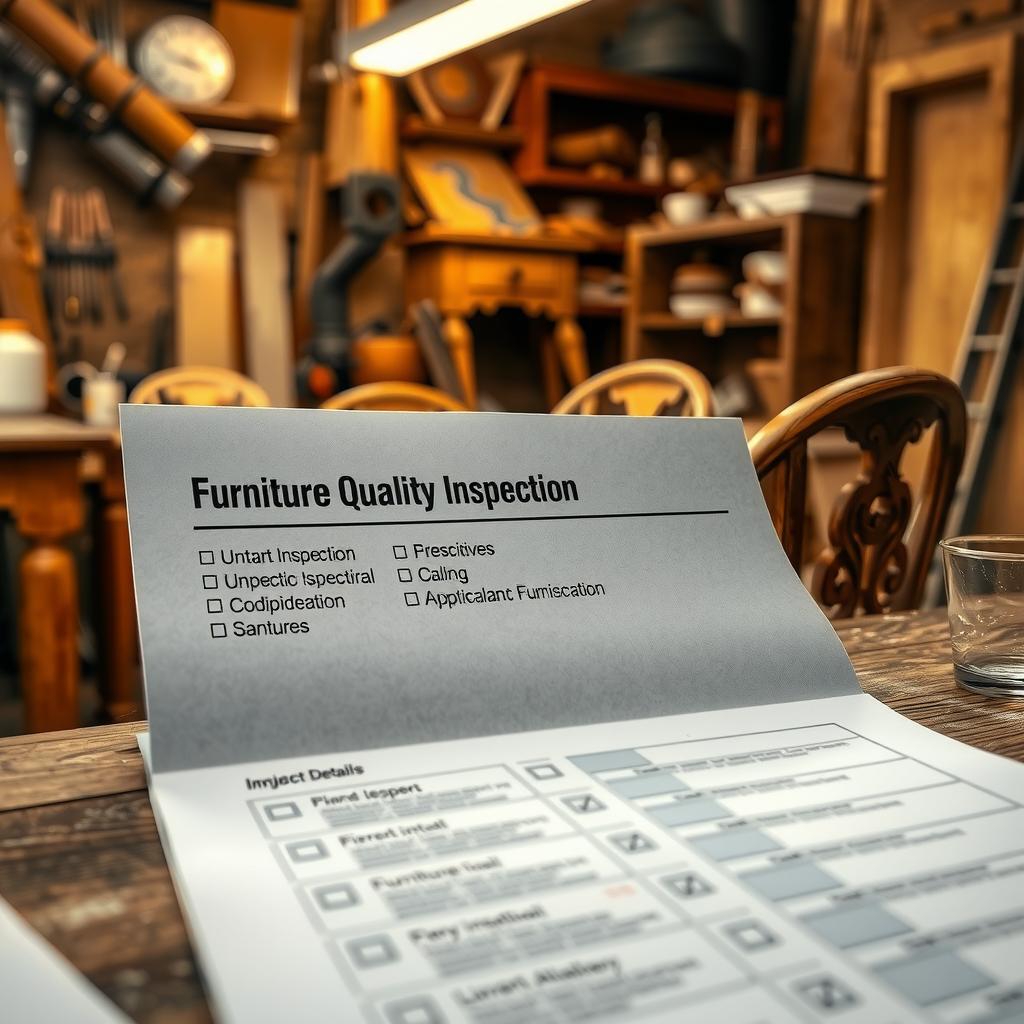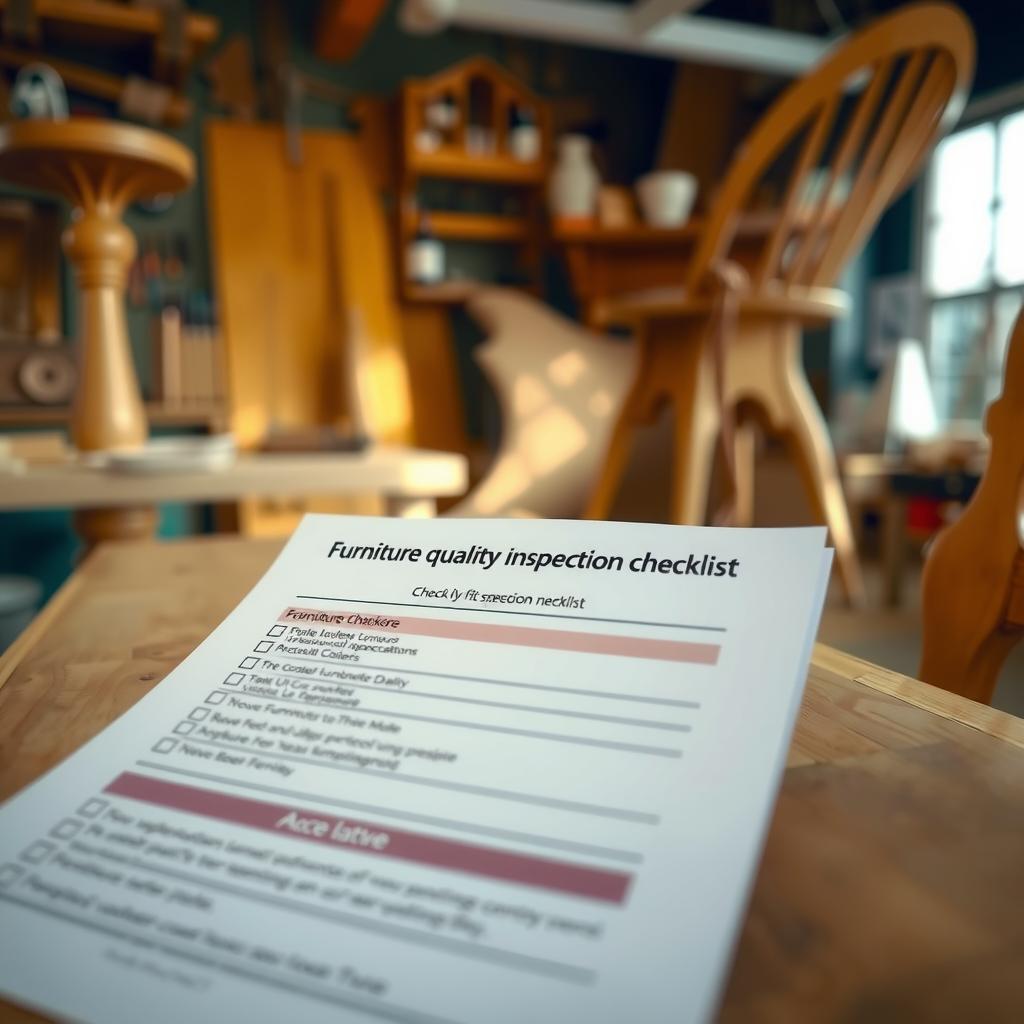In an era where consumers are increasingly discerning about the quality of their purchases, how can one ensure that the furniture they invest in meets high standards? With a plethora of options available in the market, distinguishing between well-made and subpar furniture can be a daunting task for many. This is where a comprehensive furniture quality inspection checklist becomes invaluable. By adhering to established inspection criteria, buyers not only safeguard their investment but also enhance their living spaces with enduring pieces that stand up to daily use.
The significance of conducting thorough quality inspections cannot be overstated; it serves as a pivotal step in the inspection process. A carefully crafted checklist helps identify critical aspects such as material integrity, craftsmanship, and overall durability—parameters that define what constitutes high-quality furniture. Understanding these benchmarks enables consumers to make informed decisions and avoid regrettable purchases that could leave them dissatisfied down the line.
Moreover, employing this form of quality assurance ensures compliance with industry-standard regulations related to furniture manufacturing and safety. Each item on the checklist acts as a guideline for evaluating whether prospective pieces align with established furniture standards. From assessing joinery techniques used in wooden items to examining upholstery materials for wear resistance, each criterion plays an essential role in determining value.
As readers delve into this article, they will discover how implementing an effective quality control system through detailed inspection checklists can transform their shopping experience from overwhelming to empowering. The journey towards acquiring superior-quality furniture begins here; by understanding what makes furniture exceptional through rigorous evaluation methods laid out within our comprehensive guide, individuals can confidently curate spaces filled with beauty and longevity.
In conclusion, embracing this proactive approach not only enhances individual satisfaction but also fosters a culture of quality-conscious consumerism within society at large. As we move forward into exploring specific components of our furniture quality inspection checklist, readers will gain insights necessary for making wise choices that resonate long after purchase—a true testament to investing wisely in one’s home environment.

Key Points:
-
Material Composition: Assessing the quality of materials used in furniture
A crucial aspect of any furniture inspection involves examining the material composition. Buyers should seek out pieces made from durable, high-quality materials that meet established standards. Whether it’s solid wood, metal, or upholstery fabrics, understanding how these components contribute to overall strength and longevity is essential. This emphasis on material integrity ensures that consumers invest in furniture that not only looks appealing but also withstands the test of time. -
Structural Integrity: Evaluating construction techniques for durability
The structural integrity of furniture plays a significant role in its overall performance and safety. During the inspection process, buyers should scrutinize joinery techniques, weight distribution, and stability. A well-constructed piece will demonstrate robust craftsmanship with features like reinforced joints and proper weight handling capabilities. By adhering to strict quality assurance protocols regarding structural elements, stakeholders can ensure compliance with industry standards while enhancing customer confidence in their purchases. -
Overall Craftsmanship: Identifying attention to detail through finishing touches
Exceptional craftsmanship is often revealed through meticulous attention to detail found in the finishing touches of furniture. When conducting a thorough quality checklist assessment, potential buyers should look for signs such as smooth finishes without rough edges or inconsistencies in paint or stain application. The presence of thoughtful design elements contributes significantly to both aesthetics and functionality; therefore, focusing on overall craftsmanship during inspections aids consumers in selecting superior quality items that align with high furniture standards.

Understanding Furniture Quality: Key Aspects to Consider
Exploring the Fundamental Elements of Furniture Quality
When assessing furniture quality, several fundamental elements come into play, with material composition and craftsmanship at the forefront. The materials used in furniture production can significantly impact both its durability and aesthetic appeal. High-quality wood, for instance, often includes hardwood varieties such as oak, maple, or cherry. These woods not only offer a robust structure but also provide a timeless beauty that enhances any space. In contrast, lesser-quality options like particleboard may save costs initially but typically lack longevity and resilience against wear and tear. Therefore, conducting a thorough furniture inspection is essential to ensure that the materials meet established furniture standards.
Craftsmanship is another critical factor influencing furniture quality. Well-made pieces exhibit attention to detail in their construction methods—such as dovetail joints in drawers or solid frames without staples or screws—which speak volumes about their durability and overall integrity. A comprehensive quality checklist should include these aspects during an inspection process, ensuring buyers are aware of what constitutes good craftsmanship versus poor alternatives that may compromise longevity. For example, well-crafted upholstery should feature secure stitching patterns that resist fraying over time while maintaining comfort.
Furthermore, it is crucial to consider how manufacturers implement their quality control measures throughout the production cycle. This includes adhering to rigorous inspection criteria at various stages—from raw material selection through final assembly—to guarantee each piece meets consumer expectations for safety and performance. Companies committed to quality assurance often share this information publicly as part of their brand promise; thus customers can make informed decisions when purchasing new furniture items.
In addition to traditional wood-based selections, modern advancements have introduced synthetic materials that also merit attention when discussing furniture quality—especially concerning sustainability practices within manufacturing processes today’s consumers increasingly value environmental responsibility alongside aesthetics and functionality in their choices of furnishings for home environments.
Ultimately understanding these key aspects allows individuals seeking new additions for living spaces not just purchase aesthetically pleasing products but rather investments rooted firmly within principles such as durability coupled with exquisite design resulting from exceptional craftsmanship—all vital components defining true furniture quality.
The Role of a Quality Inspection Checklist in Furniture Standards
Elevating Customer Satisfaction Through Rigorous Quality Control
In the competitive landscape of the furniture industry, ensuring that products meet stringent quality standards is paramount. A comprehensive quality inspection checklist serves as an essential tool for manufacturers and retailers alike, guaranteeing adherence to established furniture standards and enhancing overall customer satisfaction. By meticulously detailing each aspect of the inspection process, this checklist allows quality control teams to evaluate every piece against defined inspection criteria, thereby identifying potential issues before they reach consumers. This proactive approach not only minimizes defects but also reinforces the brand’s commitment to excellence in craftsmanship.
The importance of a thorough furniture inspection cannot be overstated; it encompasses various dimensions, including material integrity, design precision, and functional reliability. For instance, when evaluating wooden chairs or tables—key components within any home—the checklist prompts inspectors to assess factors such as joint strength, surface finish quality, and alignment accuracy. Each item checked off represents a step toward ensuring that customers receive products that embody durability and aesthetics. Consequently, by implementing strict adherence to a well-structured quality checklist throughout production cycles, businesses can significantly reduce returns and complaints stemming from subpar items.
Moreover, consumer expectations are continually evolving; today’s buyers demand transparency regarding product origins and manufacturing practices. A robust inspection protocol not only assures customers about the quality of their chosen furniture but also builds trust through demonstrated accountability in meeting high-quality benchmarks. When consumers can confidently rely on brands for superior products—be it plush sofas or elegant dining sets—they are more likely to become repeat buyers while endorsing their favorite brands within their circles.
Furthermore, integrating feedback loops into the quality assurance framework enhances future inspections by allowing companies to learn from past experiences with specific products or materials. By regularly updating checklists based on emerging trends in customer preferences or innovations within manufacturing technologies (like sustainable materials), businesses can stay ahead in delivering exceptional value through every piece of furniture produced.
In conclusion, maintaining rigorous standards via an effective quality inspection checklist is fundamental for any organization dedicated to providing top-notch furniture solutions that resonate with consumer demands for both form and function. As these protocols evolve alongside market needs—aided by technology advancements—the ability to ensure consistent delivery against set benchmarks will ultimately fortify customer loyalty while cementing a reputation rooted firmly in superior craftsmanship.
Proactive Quality Control Strategies: Empowering Buyers and Manufacturers
Enhancing Product Integrity Through Effective Systems
In today’s competitive market, implementing proactive quality control strategies is essential for both buyers and manufacturers to ensure that furniture products meet rigorous standards before reaching consumers. One effective method involves developing a comprehensive quality checklist that outlines the necessary criteria for assessing furniture quality at various stages of production. This checklist serves as a guide during the inspection process, allowing manufacturers to identify potential flaws early, thus preventing defective items from entering the marketplace. By adhering to established inspection criteria, manufacturers can maintain high levels of product integrity while also ensuring compliance with industry regulations.
Furthermore, adopting robust quality assurance practices not only safeguards consumer interests but also enhances brand reputation. For instance, regular training sessions for staff on furniture inspection techniques can help cultivate a culture of quality within an organization. When employees are equipped with knowledge about specific furniture standards, they become more adept at recognizing deviations from desired specifications during the manufacturing phase. By focusing on proactive measures instead of reactive fixes after issues arise, businesses can significantly reduce waste and improve operational efficiency.
Another crucial aspect is leveraging technology in the inspection process. Utilizing advanced tools such as automated systems or AI-driven software allows for real-time monitoring of production lines and facilitates quicker identification of defects in furniture materials or design inconsistencies. These technologies enable manufacturers to implement corrective actions swiftly before products proceed too far along in development or distribution channels.
Moreover, collaboration between buyers and suppliers can further enhance these proactive strategies by establishing clear communication regarding expectations related to quality control measures and product specifications. Engaging in regular dialogue ensures that all parties remain aligned on what constitutes acceptable levels of furniture quality while fostering trust throughout their supply chain relationships.
Ultimately, investing time into designing an effective quality control system tailored specifically towards furniture will empower both buyers seeking reliable products and manufacturers striving for excellence in their output.
By prioritizing these initiatives as part of their operational philosophy, stakeholders not only mitigate risks associated with subpar items but also promote sustainability through reduced returns and increased customer satisfaction—a win-win scenario for all involved!
Frequently Asked Questions:
Q: What should I look for in a furniture inspection?
A: When conducting a furniture inspection, it’s essential to evaluate aspects such as material composition, structural integrity, and overall craftsmanship. By focusing on these key areas outlined in the quality checklist, buyers can ensure that the chosen furniture meets or exceeds established standards.
Q: How does a quality checklist help improve customer satisfaction?
A: A comprehensive quality checklist guarantees adherence to quality assurance protocols, allowing manufacturers to identify potential weaknesses in their products. This proactive approach not only enhances the durability of the furniture but also leads to increased customer satisfaction as consumers receive well-crafted items that stand up to daily use.
Q: Why is understanding inspection criteria important for buyers?
A: Understanding the inspection criteria empowers buyers with knowledge about effective furniture evaluation practices. By being equipped with this information, they can make informed purchasing decisions and feel confident knowing that their selected pieces have been thoroughly assessed for quality and reliability through an effective quality control system.